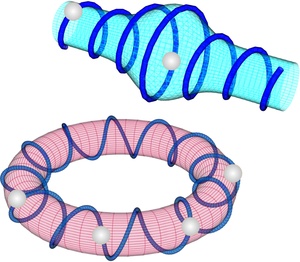Curved helical structures

Low dimensional structures are of fundamental physical importance, since they often exhibit a highly unconventional behaviour, giving rise to novel effects, such as the quantum Hall effect or the high temperature superconductivity. Geometry adds to the complexity of such structures, while offering, at the same time, means of tunability and control. We study properties of low dimensional systems, possessing a non-trivial geometry, both at a classical and a quantum level. Our research focuses on interacting particles (e.g. ions) trapped in one dimensional helical manifolds. From an experimental point of view, traps with such a complex geometry are a subject of state of the art research in nanofabrication as well as in optical and atomic physics. From a theoretical viewpoint the helical geometry is considered optimal since it is embedded in the full three dimensional space and provides a large variety of tuning parameters as well as a spatial repetition. Such features make the curved helical structures attractive setups, allowing for the emergence of various fascinating effects. Just to name a few, these include for repulsive charged particles, a novel kind of an effective oscillatory force inducing multiple classical bound states, the possibility for binding of particles through scattering and an unconventional deformation of the vibrational band structures bearing similarities to the behaviour of metamaterials, all controlled by the geometry parameters.
